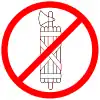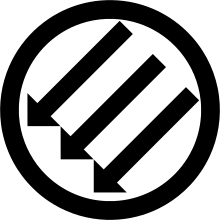| Iron Front | |
|---|---|
| Eiserne Front | |
 A widely publicized election poster of the Social Democratic Party of Germany from 1932, with Three Arrows symbol representing resistance against monarchism, Nazism and Communism, and with the slogan "Against Papen (monarchist candidate), Hitler (Nazi candidate), Thälmann (Communist candidate)." | |
| Active regions | Germany |
| Ideology | |
| Political position | Left-wing |
| Opponents | |
| Part of a series on |
| Anti-fascism |
|---|
 |

The Iron Front (German: Eiserne Front) was a German paramilitary organization in the Weimar Republic which consisted of social democrats, trade unionists, and democratic socialists. Its main goal was to defend democratic socialism and liberal democracy against what was viewed as totalitarian ideologies on the far-right and far-left. The Iron Front chiefly opposed the Sturmabteilung (SA) wing of the Nazi Party and the Antifaschistische Aktion wing of the Communist Party of Germany.[1] Formally independent, it was intimately associated with the Social Democratic Party of Germany (SPD). The Three Arrows, originally designed for the Iron Front, became a well-known social democratic symbol representing resistance against monarchism, Nazism, and Marxism-Leninism during the parliamentary elections in November 1932. The Three Arrows were later adopted by the SPD itself.[2]
History
The Iron Front was formed on 16 December 1931 in the Weimar Republic by the Social Democratic Party (SPD), along with the Allgemeiner Deutscher Gewerkschaftsbund (ADGB), the Reichsbanner Schwarz-Rot-Gold, and workers' sport clubs.[3] The Iron Front chiefly opposed the paramilitary organisations of both the fascist National Socialist German Workers Party (NSDAP), i.e. the Nazi Party, and the Communist Party of Germany (KPD). Its initial purpose was to counter the right-wing Harzburg Front. The organization sought to engage the old Reichsbanner, the SPD youth organization, and labour and liberal groups, as a united front. The SPD rallied to the Iron Front, held mass demonstrations, armed themselves, and fought the Nazi SA and Communist RFB in the streets. This was more than the SPD leaders wanted, but SPD workers grew increasingly militant in their resistance against the communist and fascist movements threatening the Weimar Republic.
The Iron Front was regarded as an anti-communist and "social fascist terror organisation" by the KPD, who regarded the SPD as their main adversary.[4] In response to the formation of the Iron Front, the KPD founded its own activist wing, Antifaschistische Aktion (Antifa), which opposed the social democrat SPD and the fascist NSDAP.[5]
On January 30, 1933, the day Hitler was appointed Chancellor, the KPD asked the Iron Front, the SPD, the general trade union association ADGB and their organisations, and the Reichsbanner Schwarz-Rot-Gold to declare a general strike against Hitler. The Iron Front declined, issued a call on February 2 to "all comrades of the Reichsbanner and the Iron Front", warning against participating in "wild actions organised by irresponsible people", and exhorted members to "turn all Iron Front events into powerful rallies for freedom".[6]
On March 3, the Iron Front planned a march in Kassel, but was hindered by regular police. On May 2, all trade unions, with which the Iron Front was closely allied, were finally abolished, together with all trade union structures.[7] Until the mid 1930s and in some cases until the war years, some local branches of the Iron Front and the former trade union organisations continued with resistance, mostly by spreading leaflets, organizing secret meetings, and carrying out acts of sabotage.[8]
Its logo, the Three Arrows (pointing southwest) was designed by Sergei Chakhotin, former assistant to the physiologist Ivan Pavlov in 1931.[9][10][11] Designed so as to be able to easily cover Nazi swastikas, the meaning of the three arrows has been variously interpreted. The present-day Reichsbanner association says the arrows of the logo stood for the SPD, the trade unions, and the Reichsbanner Schwarz-Rot-Gold, as well as for the political, economic, and physical strength of the working class.[12] The symbol was used on a November 1932 Reichstag election poster of the SPD to represent opposition to the Nazi Party, the Communist Party, and the monarchist wing of the Centre Party.[13]
About its formation, Karl Höltermann, chairman of the Reichsbanner, commented: "The year 1932 will be our year, the year of victory of the republic over its opponents. Not one day nor one hour more do we want to remain on the defensive. We attack! Attack on the whole line! We must be part of the general offensive. Today we call - tomorrow we strike!"[14]
Legacy
The Three Arrows became a symbol of the social democratic resistance against the ideologies of Nazism and Soviet Style State Socialism.[2] More recently, the symbol has been appropriated by American anti-fascist movements, along with flags historically derived from the German Communist Party's Antifaschistische Aktion.[15] Antifa opposed the Iron Front, whom they regarded as bourgeois and fascist, as the Three Arrows logo was used to represent resistance against Antifa's affiliated party, the KPD as well.[2]
The Iron Front flag has been adopted by supporters of MLS team Portland Timbers and frequently seen at their games. Major League Soccer banned the flag in 2019 as part of a crackdown on "political symbols," although the league walked back the ban weeks later.[16]
See also
Footnotes
- ↑ Harsch, Donna (2009). The Iron Front: Weimar Social Democracy between Tradition and Modernity (1 ed.). Berghahn Books. pp. 251–274. ISBN 978-1-57181-120-2. JSTOR j.ctt9qcp9v.
{{cite book}}:|work=ignored (help) - 1 2 3 Potthoff, Heinrich; Faulenbach, Bernd (1998). Sozialdemokraten und Kommunisten nach Nationalsozialismus und Krieg: zur historischen Einordnung der Zwangsvereinigung. Klartext. p. 27.
- ↑ Andreas Linhardt (2006). Die Technische Nothilfe in der Weimarer Republik. Dissertation: Braunschweig University of Technology. p. 667. ISBN 978-3-8334-4889-8. Retrieved 6 August 2011 (in German).
- ↑ Siegfried Lokatis: Der rote Faden. Kommunistische Parteigeschichte und Zensur unter Walter Ulbricht. Böhlau Verlag, Köln 2003, ISBN 3-412-04603-5 (Zeithistorische Studien series, vol. 25), p. 60|quote=Thälmann hatte die SPD als „Hilfspolizei für den Faschismus“, als „verräterische und volksfeindliche Partei“, ihre Führer als „berufsmäßige Arbeiterverräter“, „Kapitalsknechte“ und „Todfeinde des Sozialismus“, die Eiserne Front als „Terrororganisation des Sozialfaschismus“ beschimpft und die „Liquidierung der SAJ als Massenorganisation“ gefordert. [Thälmann had insulted the SPD as "auxiliary police for fascism" and a "treacherous and anti-people party", its leaders as "professional traitors", "servants of capital", and "mortal enemies of socialism", the Iron Front as a "terrorist organization of social fascism", and declared that the "Liquidation of the SAJ as a mass organization" was required.]
- ↑ Langer, Bernd (2012). 80 Jahre Antifaschistische Aktion (PDF). Göttingen: Verein zur Förderung antifaschistischer Kultur.
- ↑ Hessischer Volksfreund 2.2.1933, In: VVN-BdA, Das Jahr 1933, https://dasjahr1933.de/eiserne-front-und-reichsbanner-warnen-vor-wilden-aktionen-2-februar-1933/
- ↑ VVN-BdA, Das Jahr 1933/
- ↑ Heinz, Stefan, Interview with Gerda Henkel Stiftung, 15 December 2015
- ↑ Friedrich-Wilhelm Witt (1971). "Die Hamburger Sozialdemokratie in der Weimarer Republik". Unter besonderer Berücksichtigung der Jahre 1929/30 – 1933 ("Hamburg Social Democracy in the Weimar Republic". With special consideration of the years 1929/30 – 1933). Hannover. p. 136.
- ↑ Sergei Tschachotin (1933). Dreipfeil gegen Hakenkreuz ("Three Arrows Against the Swastika"). Kopenhagen. Book was reviewed by Dieter Rebentisch (1972) in the periodical Archiv für Sozialgeschichte ("Archives for Social History"). No. 12. p. 679–???. ISSN 0066-6505.
- ↑ Richard Albrecht (January 2005). "Dreipfeil gegen Hakenkreuz" – Symbolkrieg in Deutschland 1932 ("Three Arrows Against the Swastika" – symbol war in Germany 1932". Historical Case-Study in Anti-Nazi-Propaganda Within Germany and Western Europe, 1931-35).
- ↑ "Die Eiserne Front". Archived 7 October 2011 at the Wayback Machine Bundesverband Reichbanner Schwarz-Rot-Gold, Bund Aktiver Demokraten e. V. Retrieved 6 August 2011 (in German).
- ↑ "SPD poster for 1932 elections". Retrieved 6 August 2011 (in German).
- ↑ Werner K. Blessing (2003). "Dok. 9 Aufruf des Bundesvorsitzenden Karl Höltermann, Anfang Januar 1932". Bayerische Landeszentrale für Politische Bildungsarbeit. Die Weimarer Republik Band III. Retrieved 6 August 2011 (in German).
- ↑ Friedmann, Sarah (August 15, 2017). "This Is What The Antifa Flag Symbols Mean". Bustle. Retrieved 16 April 2019.
- ↑ Rosenberg, Eli (31 August 2019). "There is an anti-fascist rebellion brewing in the Pacific Northwest. And soccer is at the center of it". The Washington Post. Retrieved 7 January 2021.
Further reading
- "Reichsbanner Schwarz-Rot-Gold - Themen: Die Eiserne Front". Reichsbanner Schwarz-Rot-Gold - Reichsbanner Geschichte (in German). Retrieved 2020-12-18.